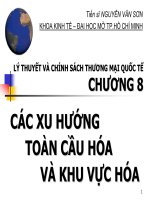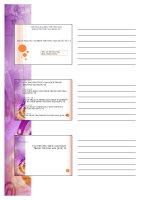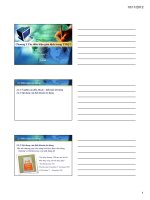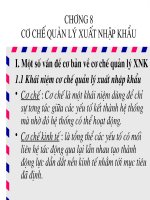Slide thương mại quốc tế chapter 8 measuring the amount of protection
Bạn đang xem bản rút gọn của tài liệu. Xem và tải ngay bản đầy đủ của tài liệu tại đây (267.11 KB, 14 trang )
11/1/2012
Measuring the amount of protection
• ERP (Effective Rate of Protection)
♦
measures how much protection a tariff/ other trade
policies actually provides domestic producers.
• ERP measures the protection by a tariff offered to
domestic value added (VA)
♦
Represents the change in value that an industry
adds to the production process when trade policy
changes (value added).
♦
The change in value that an industry provides
depends on the change in prices when trade
policies change.
Measuring the amount of protection
• ERP (Effective Rate of Protection)
♦
measures how much protection a tariff/ other trade
policies actually provides domestic producers.
• ERP measures the protection by a tariff offered to
domestic value added (VA)
♦
Represents the change in value that an industry
adds to the production process when trade policy
changes (value added).
♦
The change in value that an industry provides
depends on the change in prices when trade
policies change.
Measuring the amount of protection (cont.)
ERP =
Vt − Vw
Vw
- ERP: Effective Rate of Protection
- Vt: Value added in presence of tariff
- Vw: Value added in free trade
1
Vu Thanh Huong, UEB - VNU
CuuDuongThanCong.com
/>
11/1/2012
Measuring the amount of protection (cont.)
ERP =
t − a iti
(1 )
1 − ai
ERP: Effective of protection to producers of the final
commodity
t :
The nominal tariff on consumers of the final
commodity
ai:
The ratio of the cost of the imported inputs to the
ti :
The nominal tariff rate on the imported input
price of the final commodity in the absence of tariffs
Measuring the amount of protection (cont.)
• Example:
♦
World price of a car:
$8,000
♦
Parts
$6,000
• Compare two nations:
♦
Nation 1: wants to develop an auto assembly
industry
♦
Nation 2: (already has an assembly industry) and
wants to develop a parts industry.
Measuring the amount of protection (cont.)
• Nation 1: wants to develop an auto assembly industry
♦
World price of a car:
$8,000
♦
Parts
$6,000
♦
Value added at world price (Vw ) $2,000
♦
A tariff of 25% on cars imported and no tariff on
parts
♦
Price of car post 25% tariff
$10,000
♦
Parts
$ 6,000
♦
Value added post-tariff (VT)
$ 4,000
♦
ERP = 100%
=> The protection offered by the nominal tariff for
cars industry is only 25%, but the ERP is 100%.
2
Vu Thanh Huong, UEB - VNU
CuuDuongThanCong.com
/>
11/1/2012
Measuring the amount of protection (cont.)
• Nation 2: wants to develop a parts industry
♦
World price of a car:
$8,000
♦
Parts
$6,000
♦
Value added at world price (Vw ) $2,000
♦
A tariff of 25% on imported parts but 0% on cars imported
♦
Price of car
$8,000
♦
Price of Parts after 10% tariff
$6,600
♦
Value added post-tariff (VT)
$1,400
• Negative ERP reveals that it would be cheaper to
import cars rather than assemble cars domestically.
=> whilst providing protection to domestic
manufacturers of parts, discourages the domestic car
assembly industry by providing a negative ERP of 30% :
Measuring the amount of protection (cont.)
• If a tariff imposed on final car > a tariff
imposed on parts => positive ERP and
ERP > t
• If a tariff imposed on final car < a tariff
imposed on parts => negative ERP and
ERP < t
• If a tariff imposed on final car = a tariff
imposed on parts => ERP = t (nominal
tariff)
• Escalation tariff => positive ERP and
ERP > t
Measuring the amount of protection (cont.)
ERP with many inputs
A pair of
shoes
Leather
Embroider
Price in free trade (USD)
100
60
10
Import tariff (%)
20
20
30
Price with tariff (USD)
120
72
13
•
Value added of a pair of shoes in free trade: 30 USD
•
Value added of a pair of shoes with tariff: 35 USD
•
Nominal tariff on a pair of shoes is 20%
•
ERP for a pair of shoes: 16.67% = (35-30)/30
3
Vu Thanh Huong, UEB - VNU
CuuDuongThanCong.com
/>
11/1/2012
EXPORT SUBSIDIES
Concept of Export Subsidies
• An export subsidy: a payment to a firm or
individual that ships a good abroad.
• An export subsidy can also be specific or ad
valorem
♦
A specific subsidy is a payment per unit exported.
♦
An ad valorem subsidy is a payment as a
proportion of the value exported.
• US: subsidize agricultural products.
• Vietnam: has to abolish export subsidies
Effects of Export Subsidies
• The effects of an export subsidy are the reverse
of those of a tariff.
• Shipper will export the good up to the point where
the domestic price exceeds the foreign price by
the amount of subsidy.
♦
The difference between the domestic price in the
exporting countries and the foreign price is exactly the
subsidy
• Examine effects of export subsidies in two cases
♦
Small exporting country case
♦
Large exporting country case
4
Vu Thanh Huong, UEB - VNU
CuuDuongThanCong.com
/>
11/1/2012
Effects of Export Subsidies in a large
country case
Ps
Pw
Pw
P*s
Effects of Export Subsidies in a large
country case (cont.)
• In the exporting country: an export subsidy
♦
Raises the domestic price of a good in the
exporting country from PW to PS
♦
Makes its consumer surplus decrease
♦
Makes its producer surplus increase
♦
Government loses because it must spend money
on the subsidy.
Effects of Export Subsidies in a large
country case (cont.)
• In the importing country:
♦
An export subsidy raises the price of a good in the
exporting country, while lowering it in foreign
countries from PW to PS’.
• The price rise in the exporting country is less
than the subsidy per unit of product.
• In contrast to a tariff, an export subsidy
worsens the terms of trade by lowering the
price of domestic products in world markets.
5
Vu Thanh Huong, UEB - VNU
CuuDuongThanCong.com
/>
11/1/2012
Costs and benefit of Export Subsidies in
a large country case
Cost of a subsidy = - (b+d) – (e+f+g)
Costs and Benefits of Export Subsidies
in a large country case (cont.)
• In the (large) exporting country: an export
subsidy
♦
Loss in consumer surplus
= (a+b)
Gain in producer surplus
= (a+b+c)
♦ Cost of government subsidy
= (b+c+d+e+f+g)
⇒ Loss in national welfare:
= (b+d+e+f+g)
⇒ An export subsidy unambiguously produces a negative
effect on national welfare.
♦
Effects of Export Subsidies in a large
country case (cont.)
• The triangles b and d represent the efficiency
loss.
♦
The tariff distorts production and consumption
decisions: producers produce too much and
consumers consume too little compared to the
market outcome.
• The area b + c + d + f + g represents the cost
of government subsidy.
♦
In addition, the terms of trade decreases, because
the price of exports falls in foreign markets from PW
to P*s.
6
Vu Thanh Huong, UEB - VNU
CuuDuongThanCong.com
/>
11/1/2012
The effects of export subsidies
in a small country case
P
When a country is “small”
Export after subsidy
S
C
PS
s
a
c
b
PW
d
=> Foreign price will not fall, but
will remain at Pw
G
F
E
D
Q3
Q1
Q2
=> Has no effect on the foreign
(world) price.
⇒ Home price will rise to Ps = Pw
+s
⇒ Does not lead to change in
Q
terms of trade
Q4
Export before subsidy
⇒ Difference between Home and
Foreign pirce is still subsidy
The effects of export subsidies
in a small country case
P
Export after subsidy
PS
s
S
C
a
c
b
PW
d
G
F
E
Consumer loss = a + b
Producer gain =
a+b+c
Cost of government subsidy
=
b+c+d
Cost of a export subsidy
=
(b+d)
D
Q3
Q1
Q2
Q4
Q
Export before subsidy
IMPORT QUOTAS
7
Vu Thanh Huong, UEB - VNU
CuuDuongThanCong.com
/>
11/1/2012
Concept of an import quota
• An import quota:
♦
A direct restriction on the quantity of a good
that may be imported.
♦
The role of quota decreases (WTO, FTAs)
♦
Usually enforced by issuing licenses to
domestic firms that import, or in some cases to
foreign governments of exporting countries.
Effects of an import quota (cont.)
• Import quota always raises the domestic price
of imported good because at the initial price,
the quantity demanded will exceed the
quantity supplied by domestic producers and
from imports.
• Raise the domestic price by the same amount
as a tariff that limits imports to the same level
(equivalent tariff).
=> Impacts of quota is similar to impacts of an
equivalent tariff.
Effects of an import quota (cont.)
• The difference between a tariff and a quota is
the government receives no revenue
♦
Instead, the revenue from selling imports at high
prices goes to quota license holders (either
domestic firms or foreign governments).
♦
License holders import goods and resell them at
higher prices.
♦
The profits received by the holders of import
license are called quota rents.
8
Vu Thanh Huong, UEB - VNU
CuuDuongThanCong.com
/>
11/1/2012
Effects of an import quota (cont.)
• Costs and benefits of an import quota
depends on who gets the rent.
♦
If license holders are domestic firms, an import
quota have the similar effects as a tariff that limits
imports to the same level (an equivalent tariff)
♦
If license holders are governments of exporting
countries => the costs of an import quota is higher
than those of the equivalent tariff.
• Cost of an import quota is (b+d)
• Cost of an import quota is (b+d+c)
US Import Quota on Sugar
TARIFF RATE QUOTA (TRQ)
9
Vu Thanh Huong, UEB - VNU
CuuDuongThanCong.com
/>
11/1/2012
Tariff rate quota
• Combination of tariff and quota
♦ Low
tariff for imports below quota
tariff for imports above quota
Common in agricultural trade
♦ High
♦
Example of TRQ
• Vietnam started to use TRQ in 2003 for 3 commodities:
salt, cotton, material tobacco
Commodities
Number of
tariff lines
In-quota tariff (%)
Out-of-quota tariff
(%)
Material tobacco
12
28.7
98.3
Salt
7
0
60
Cotton
5
0
16
• In 2004, TRQ were applicable to 4 additional
commodities: maize, egg, condensed milk, and
uncondensed milk
69
Example of TRQ (cont.)
• In 2011: Circular 45/2010/TT-BCT dated
31/12/2010, came into effect in 1/1/2011
regarding TRQ
♦
Commodities subject to TRQ includes egg, material
tobacco, salt, raw and refined sugar
• In 2012: Circular 111/2012/TT-BTC dated
4/7/2012, came into effect in 18/8/2012
regarding TRQ for 2012
♦
Commodities subject to TRQ includes egg, material
tobacco, salt, raw and refined sugar
10
Vu Thanh Huong, UEB - VNU
CuuDuongThanCong.com
/>
11/1/2012
Voluntary Export Restraint
(VER)
Voluntary Export Restraint (VER)
• VER: a quota on trade imposed from the exporting
country’s side instead of the importer’s.
• VER: works like an import quota, except that the
quota is imposed by the exporting country rather than
the importing country.
• These restraints are usually requested by the
importing country
• The profits or rents from this policy are earned by
foreign governments or foreign producers.
♦
Foreigners sell a restricted quantity at an increased
price.
♦
VER: is always more costly to the importing
country than the equivalent tariff (VER is exactly like
a quota where the licences are assigned to foreign
governments)
Voluntary Export Restraint (VER)
(cont.)
• Examples of VER or Orderly Marketing
Arrangements (OMA) are:
♦ Japan
automobile exports to USA (1981)
Multi-fibre agreement which restricted
garment imports from 22 countries to
developed countries until the beginning of
2005.
♦ The
11
Vu Thanh Huong, UEB - VNU
CuuDuongThanCong.com
/>
11/1/2012
Local Content Requirement
• A local content requirement is a regulation
that requires a specified fraction of a final
imported good to be produced domestically.
• It may be
♦
specified in value terms, by requiring that some
minimum share of the value of a good represent
domestic valued added
♦
in physical units.
♦
Widely used by developing countries to shift their
manufacturing base from assembly back into
intermediate goods.
Local Content Requirement (cont.)
• For domestic producers of inputs
♦
Provides protection in the same way that an import
quota would.
• For firms that must buy inputs
♦
Does not place a strict limit on imports, but allows
firms to import more provided they also buy more
domestic parts.
• For government
♦
Provides no government revenue (as a tariff
would).
Other Trade Policies
• Export credit subsidies
♦
A subsidized loan to exporters
♦
US Export-Import Bank subsidizes loans to US
exporters.
♦
Vietnam:
• Decision 75/2011/NĐ-CP
• Government procurement
♦
Government agencies are obligated to purchase
from domestic suppliers, even when they charge
higher prices (or have inferior quality) compared to
foreign suppliers.
♦
EU telecoms compelled to buy high cost EU inputs
12
Vu Thanh Huong, UEB - VNU
CuuDuongThanCong.com
/>
11/1/2012
Other Trade Policies (cont.)
• Bureaucratic regulations (Red-tap
barriers)
♦ />
_e/tif_e/agrm9_e.htm
♦ Safety,
health, quality or customs
regulations can act as
a form of protection and trade restriction.
♦ In
1982, all Japanese videocassette
recorders must pass through the tiny
customs house at Poiters
Presentation assignment
• Group 3: Car trade war between US and
Japan: causes, process and impacts.
• Group 1: Boeing and Airbus trade war
• Next week
Summary
Tariff
Export
subsidy
Import
quota
Voluntary
export
restraint
Producer
surplus
Increases
Increases
Increases
Increases
Consumer
surplus
Decreases
Decreases
Decreases
Decreases
Government
net revenue
Increases
Decreases
Ambiguous,
falls for small
country
Decreases
National
welfare
No change:
No change:
rents to
rents to
license holders foreigners
Ambiguous,
Decreases
falls for small
country
13
Vu Thanh Huong, UEB - VNU
CuuDuongThanCong.com
/>
11/1/2012
Summary (cont.)
1. A tariff decreases the world price of the
imported good when a country is “large”,
increases the domestic price of the imported
good and reduces the quantity traded.
2. A quota does the same.
3. An export subsidy decreases the world
price of the exported good when a country
is “large”, increases the domestic price of
the exported good and increases the
quantity produced.
Summary (cont.)
4. The welfare effect of a tariff, quota and export
subsidy can be measured by:
♦
Efficiency loss from consumers and producers
♦
Terms of trade gain or loss
5. With import quotas, voluntary export restraints and
local content requirements, the government of the
importing country receives no revenue.
6. With voluntary export restraints and occasionally
import quotas, quota rents go to foreigners.
END OF CHAPTER 8
14
Vu Thanh Huong, UEB - VNU
CuuDuongThanCong.com
/>









